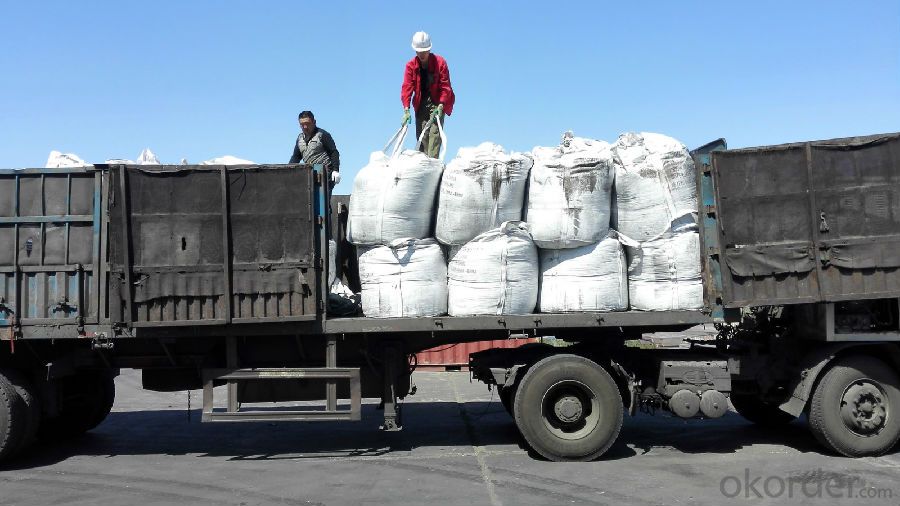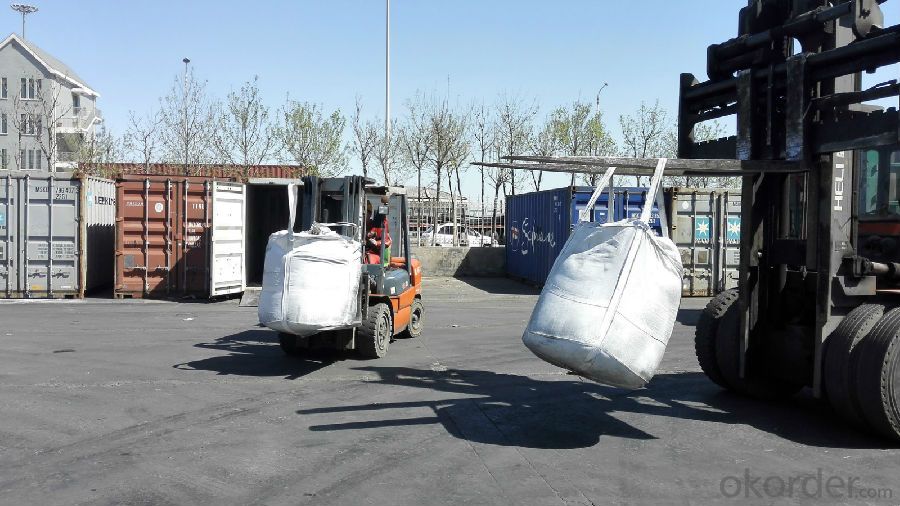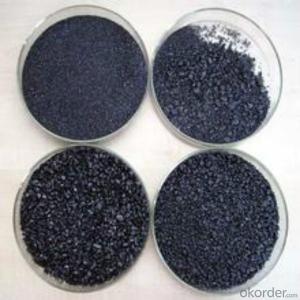GCA made from Taixi Anthracitte with Ash 4% for steel making
- Loading Port:
- Tianjin
- Payment Terms:
- TT OR LC
- Min Order Qty:
- 21.5
- Supply Capability:
- 1015 m.t./month
OKorder Service Pledge
OKorder Financial Service
You Might Also Like
Introduction:
Calcined anthracite can be called carbon additive, carbon raiser, recarburizer, injection coke, charging coke, gas calcined anthracite.It is playing more and more important role in the industry
Best quality Anthracite as raw materials through high temperature calcined at over 2000℃ by the DC electric calciner with results in eliminating the moisture and volatile matter from Anthracite efficiently, improving the density and the electric conductivity and strengthening the mechanical strength and anti-oxidation. It has good characteristics with low ash, low resistivity, low sulphur, high carbon and high density. It is the best material for high quality carbon products. It is used as carbon additive in steel industry or fuel.
Features:
G-High Calcined Anthracite is produced when Anthracite is calcined under the temperature of 1240°C in vertical shaft furnaces. G-High Calcined Anthracite is mainly used in electric steel ovens, water filtering, rust removal in shipbuilding and production of carbon material. We are honored to build a long-term relationship with the clients from the world
Specifications:
F.C.% | 95MIN | 94MIN | 93MIN | 92MIN | 90MIN | 85MIN | 84MIN |
ASH % | 4MAX | 5MAX | 6 MAX | 6.5MAX | 8.5MAX | 12MAX | 13MAX |
V.M.% | 1 MAX | 1MAX | 1.0MAX | 1.5MAX | 1.5MAX | 3 MAX | 3 MAX |
SULFUR % | 0.3MAX | 0.3MAX | 0.3MAX | 0.35MAX | 0.35MAX | 0.5MAX | 0.5MAX |
MOISTURE % | 0.5MAX | 0.5MAX | 0.5MAX | 0.5MAX | 0.5MAX | 1MAX | 1MAX |
Pictures




FAQ:
Packing:
(1). Waterproof jumbo bags: 800kgs~1100kgs/ bag according to different grain sizes;
(2). Waterproof PP woven bags / Paper bags: 5kg / 7.5kg / 12.5kg / 20kg / 25kg / 30kg / 50kg small bags;
(3). Small bags into jumbo bags: waterproof PP woven bags / paper bags in 800kg ~1100kg jumbo bags.
Payment terms
20% down payment and 80% against copy of B/L.
Workable LC at sight,
- Q:Is carbon a conductor?
- Graphite is a conductor, diamond is notGraphite is a layer, C structure can guide electrons, but diamond is stable, C structure can not guide electronsTo see whether a substance is a conductor, the key is to see if it can lead to electrons - - this is an explanation in a middle school book
- Q:Carbon emissions trading stocks latest list of carbon emissions trading stocks what?
- Carbon trading concept of a total of 21 listed companies, of which 12 carbon trading concept listed companies trading on the Shanghai Stock Exchange, and 9 other carbon trading concept listed companies trading in the Shenzhen stock exchange.Automatic matching based on the cloud financial leading excavator, carbon trading stocks leading shares most likely from the following stock was born in Tianke, electrical, environmental protection up to confidence.
- Q:What is the importance of carbon dating in archaeology?
- Carbon dating is of utmost importance in archaeology as it plays a crucial role in determining the age of artifacts and archaeological sites. This scientific method allows archaeologists to establish a chronological framework and understand the timeline of human history. The technique of carbon dating relies on the fact that all living organisms contain a certain amount of radioactive carbon-14, which decays at a predictable rate over time. By measuring the amount of carbon-14 remaining in an artifact or organic material, archaeologists can calculate its age. This method is particularly useful for dating organic remains, such as bones, charcoal, and plant fibers, which are often found at archaeological sites. The importance of carbon dating lies in its ability to provide a precise and reliable estimation of an artifact's age. This information is crucial for interpreting and understanding the context and significance of archaeological finds. By assigning an accurate date to an object or site, archaeologists can establish connections between different artifacts, societies, and cultures. This, in turn, helps to reconstruct ancient civilizations and their development over time. Furthermore, carbon dating is also valuable for refining and validating historical timelines. It allows archaeologists to cross-reference and verify the dating of artifacts and sites using other dating methods, such as dendrochronology (tree-ring dating) or stratigraphy (the study of rock layers). The combination of multiple dating techniques enhances the accuracy and reliability of archaeological interpretations. Carbon dating also assists in identifying and distinguishing between genuine artifacts and forgeries. By analyzing the age of an object, archaeologists can determine if it aligns with the historical context it claims to belong to. This is particularly important in the field of art and antiquities, where the market for fakes and forgeries can be lucrative. Overall, carbon dating is a vital tool in archaeology as it allows researchers to establish the chronology of ancient civilizations, validate historical timelines, and identify genuine artifacts. It provides valuable insights into our past, helping us better understand and appreciate the rich tapestry of human history.
- Q:How does carbon affect the formation of hurricanes?
- Carbon does not directly affect the formation of hurricanes, as their development is primarily influenced by factors such as warm ocean temperatures, atmospheric instability, and moisture content. However, carbon emissions and climate change can indirectly impact hurricanes by contributing to rising sea levels, which can exacerbate storm surge flooding during a hurricane event. Additionally, some studies suggest that climate change may lead to more intense hurricanes in the future, although the exact relationship between carbon and hurricane intensity is still an active area of research.
- Q:What are the impacts of carbon emissions on marine life?
- Marine life is significantly affected by carbon emissions, particularly the release of carbon dioxide (CO2) from burning fossil fuels. The primary consequence is ocean acidification, which occurs when seawater absorbs excess CO2, leading to a decrease in pH levels. This acidification has harmful effects on marine organisms, especially those with calcium carbonate shells or skeletons like corals, mollusks, and some plankton. As pH levels decrease, it becomes more challenging for these organisms to construct and maintain their shells. This can result in slower growth rates, weaker shells, and increased susceptibility to predation and disease. Furthermore, the dissolution of calcium carbonate shells due to ocean acidification can disrupt the entire food chain, as many organisms rely on these shells for protection or as a food source. In addition, carbon emissions contribute to global warming, resulting in rising sea temperatures. Warmer waters can cause coral bleaching, where corals expel the colorful algae living within their tissues, ultimately leading to the loss of their primary food source and eventual death. Coral reefs are crucial ecosystems that support a diverse range of marine life, and their decline has extensive consequences for biodiversity and coastal communities dependent on them for tourism and fisheries. The impacts of carbon emissions on marine life extend beyond individual species and ecosystems. Climate change, driven by carbon emissions, can disrupt ocean currents, alter weather patterns, and affect nutrient availability. These changes can influence the distribution and abundance of marine organisms, leading to shifts in species composition and potential loss of biodiversity. It is important to note that the impacts of carbon emissions on marine life are interconnected with other stressors such as overfishing, pollution, and habitat destruction. These combined pressures worsen the vulnerability of marine ecosystems and increase the risk of irreversible damage. To mitigate the impacts of carbon emissions on marine life, it is crucial to reduce greenhouse gas emissions. This can be achieved by transitioning to cleaner and renewable energy sources, improving energy efficiency, and adopting sustainable practices. Additionally, protecting and restoring marine habitats, implementing sustainable fishing practices, and reducing pollution can enhance the resilience of marine ecosystems and promote the recovery of marine life.
- Q:What is electrical carbon?
- Carbon and graphite have the following characteristics:(1) it has good conductivity and thermal conductivity.2. It has excellent properties of high temperature resistance, can work at 3000 degrees under anaerobic condition, and has good mechanical strength and thermal shock resistance at high temperature.(3) good chemical stability, not adhesion to liquid metal at high temperature, only with strong oxidant.(4) graphite has good self lubrication characteristics.The electricity production process is as follows: firstly, the carbon powder and adhesive agent he mixed pressed carbon matrix material. And then send the person inside the furnace and high temperature sintering, the final form of electrical carbon products.
- Q:Which carbon content is larger, steel or pig iron?
- carbon content more than 2.11% of iron, iron carbon content in general industry 2.5%--4%. I hope I can help you.
- Q:What does "carbon neutrality" mean?
- This new term comes from English, "Carbon Neutral"". At present, there is no uniform and fixed name in Chinese, such as carbon neutral, carbon neutral, carbon footprint or carbon balance. Carbon neutrality is one of the modern efforts to slow global warming. The use of this environmentally friendly way, people calculate the CO2 emissions of their daily activities directly or indirectly, and calculate the economic costs to offset the carbon dioxide required, and pay for specialized enterprises or institutions, the amount of carbon dioxide by their corresponding trees or other environmental protection projects to offset the atmosphere.
- Q:What is carbon neutral certification?
- The process of carbon neutral certification involves evaluating and verifying organizations, products, or services to ensure they have a carbon footprint that equals zero. This requires taking significant measures to reduce greenhouse gas emissions and offsetting any remaining emissions through the purchase of carbon credits or investments in projects that remove carbon dioxide from the atmosphere. To achieve carbon neutrality, entities undergo a thorough assessment that measures their carbon emissions, sets reduction targets, implements initiatives to reduce their carbon footprint, and tracks progress. After reducing emissions as much as possible, any remaining emissions are offset by investing in verified projects such as reforestation, renewable energy, or energy efficiency projects that reduce greenhouse gases. Certification is conducted by an independent third-party organization to evaluate and verify carbon neutrality claims, ensuring transparency and credibility. Once certified, organizations or products can display the carbon neutral label to demonstrate their commitment to environmental sustainability and responsible carbon management. Carbon neutral certification is crucial as it offers a standardized and recognized method for organizations and products to showcase their dedication to combating climate change. It enables consumers and stakeholders to make informed choices by supporting entities that have taken concrete steps to reduce their carbon emissions and contribute to a more sustainable future. Moreover, carbon neutral certification encourages organizations to adopt sustainable practices and invest in environmentally positive projects, thus hastening the transition to a low-carbon economy.
- Q:What are the impacts of carbon emissions on the stability of rainforests?
- Carbon emissions have significant impacts on the stability of rainforests, leading to detrimental consequences for both the local ecosystems and the global climate. One of the most notable impacts is the direct contribution to climate change, as carbon dioxide (CO2) is a major greenhouse gas responsible for trapping heat in the atmosphere. This enhanced greenhouse effect leads to rising global temperatures, which in turn negatively affect rainforests. As temperatures increase, rainforests face several challenges. Firstly, higher temperatures can increase the frequency and intensity of droughts, making it difficult for rainforests to maintain their moisture levels. This can lead to decreased water availability for plants and animals, causing stress, reduced growth, and increased vulnerability to diseases and pests. Additionally, droughts can also increase the risk of wildfires, which can devastate large areas of rainforest and further disrupt the delicate ecosystem. Another significant impact of carbon emissions is the alteration of rainfall patterns. Climate change can disrupt the regular rainfall cycles in rainforest regions, leading to either more intense rainfall events or prolonged dry spells. These changes in precipitation patterns can disrupt the natural balance within rainforests, affecting the growth and reproduction cycles of plants and animals. For instance, certain tree species may struggle to reproduce or regenerate if their seeds require specific conditions that are no longer met due to altered rainfall patterns. Furthermore, carbon emissions contribute to increased atmospheric concentrations of CO2, which can directly affect the physiological processes of plants. While some studies suggest that higher CO2 levels can initially enhance plant growth through increased photosynthesis, the long-term effects are more complex. Elevated CO2 can alter the nutrient balance within rainforest ecosystems and may favor certain plant species over others, leading to shifts in species composition and potentially reducing overall biodiversity. Lastly, the impacts of carbon emissions on rainforests extend beyond the local ecosystem. Rainforests are crucial carbon sinks, absorbing a significant amount of the world's CO2 emissions. However, as rainforests face increased stress from climate change, their ability to absorb and store carbon may diminish. This creates a dangerous feedback loop, as reduced carbon storage in rainforests leads to even higher atmospheric CO2 levels, further exacerbating climate change. In conclusion, carbon emissions have profound impacts on the stability of rainforests. From contributing to climate change and altering rainfall patterns to affecting plant physiology and reducing carbon storage capacity, the consequences are far-reaching and detrimental. Protecting rainforests and reducing carbon emissions are essential steps in preserving the stability and biodiversity of these vital ecosystems.
1. Manufacturer Overview |
|
|---|---|
| Location | |
| Year Established | |
| Annual Output Value | |
| Main Markets | |
| Company Certifications | |
2. Manufacturer Certificates |
|
|---|---|
| a) Certification Name | |
| Range | |
| Reference | |
| Validity Period | |
3. Manufacturer Capability |
|
|---|---|
| a)Trade Capacity | |
| Nearest Port | |
| Export Percentage | |
| No.of Employees in Trade Department | |
| Language Spoken: | |
| b)Factory Information | |
| Factory Size: | |
| No. of Production Lines | |
| Contract Manufacturing | |
| Product Price Range | |
Send your message to us
GCA made from Taixi Anthracitte with Ash 4% for steel making
- Loading Port:
- Tianjin
- Payment Terms:
- TT OR LC
- Min Order Qty:
- 21.5
- Supply Capability:
- 1015 m.t./month
OKorder Service Pledge
OKorder Financial Service
Similar products
New products
Hot products





























